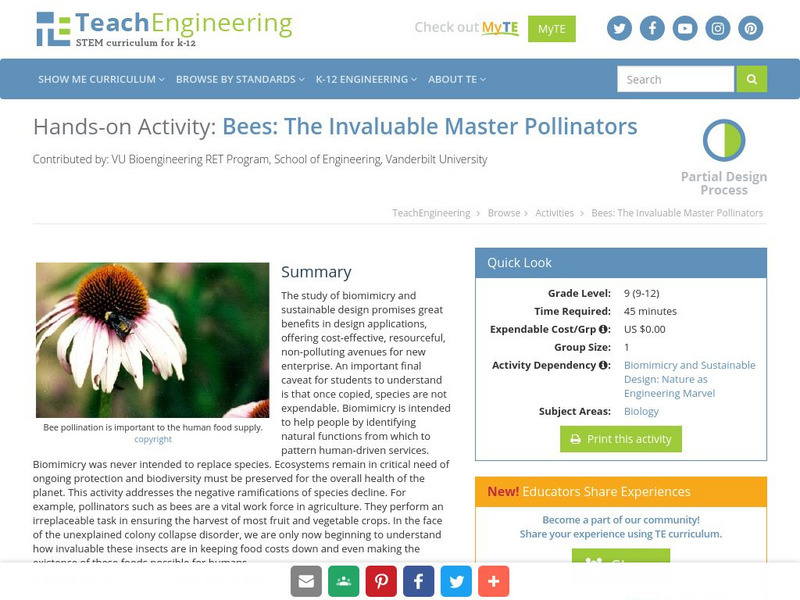Hi, what do you want to do?
Curated OER
Reading: How to Be Healthy
In this reading for information activity, students read a one page text about healthy living practices. Students then answer 8 multiple choice questions about what they have read.
Curated OER
Lemon Battery
Students construct their own battery made of lemons. In this electrochemistry lesson, students explain why lemons conduct electricity. They perform a series of experiments to investigate its conductivity.
Curated OER
Have You had Your *5 a Day*?
Students examine *5 a Day* Dole program to reinforce facts learned about nutrition.
Curated OER
The Food Pyramid
In this Internet research worksheet, students are directed to a specific site pertaining to the food pyramid. Students answer 11 questions using information they learn on the Web site.
Curated OER
Frenzied Food: Fantastic Fuel?
Students infer the causes of obesity. In this health science lesson plan, students brainstorm ways improve to their diet. They write personalized journals with goals on how to live a healthy lifestyle.
Curated OER
Picture Perfect Pyramid
Students investigate the concept of the food pyramid. The lesson includes background information for the teacher to lecture students about the food pyramid. They construct a model of the pyramid using cereal boxes. The projects could...
Curated OER
What's on Your Plate?
Middle schoolers discover foods of the Middle East. In this global studies lesson plan, students sample a falafel as they follow the provided instructions to make the dish.
Curated OER
Food Group Craze
Students play a game to learn or reinforce prior learning of the food groups within the food guide pryamid.
Curated OER
Total English Elementary
In this English review worksheet, students consolidate adverbs of frequency as they write 14 sentences following the prompts.
Curated OER
Teaching Nutrition Using the Food Guide Pyramid
Second graders explore how to make healthy eating choices. There are goals included for students to meet by the end of fifth grade.
Curated OER
Is There A Fungus Among Us?
Sixth graders classify fungus into two different groups. In this fungus lesson, 6th graders collect as many pieces of fungus as possible. Students then classify these pieces of fungus as saprophytic or parasitic.
Curated OER
Healthy Choice Shopping Frenzy
Students identify the four food groups. In this food pyramid lesson. students use pictures of food to determine what food group they belong to. Foods that are placed in the wrong place are discussed.
Curated OER
Snacks 'R Us
First graders experiment with fat content by analyzing snack foods. They learn what makes up a nutritious snack.
Centers for Disease Control and Prevention
Centers for Disease Control: Fruit and Veggies Matter
Learners explore fruits and vegetables. The activity includes a questionnaire that asks an individual's age, sex, and level of physical activity to determine the fruits and vegetables needed in an individual's diet. The resource consists...
Other
Produce for Better Health Foundation: Food Champs: Fruit and Veggie Champs
Advice, recipes, tips, nutrition information, games, and activities to help kids learn why it's so important to eat plenty of fruits and vegetables.
Other
Siemens Science Day: Life Science: Tootie Fruity
A hands-on science experiment where students examine fruits and vegetables and determine which ones are really a fruit. Students will discover how botanists define fruits and gain an understanding of plant reproduction.
Other
Mississippi Public Broadcasting: Ed Said
Meet Ed Said, a nine-year-old purple-haired hard-core fruit-and-veggie rapper. Learn nutrition facts from Ed by watching and playing his videos and songs. Includes many print-and-color activities about eating healthy fruit- and...
TeachEngineering
Teach Engineering: Bees Are Master Pollinators
The study of biomimicry and sustainable design promises great benefits in design application. It affords means by which to promote cost-effective, resourceful, non-polluting avenues for new enterprise. These "blueprints" have existed...
Texas Instruments
Texas Instruments: You'll Get a Charge Out of This!
In this activity, students make a battery using different fruits and vegetables, a copper penny, and a zinc washer. They use a voltage probe to collect data on voltage and compare the values of different batteries.
PBS
Pbs Teachers: An Apple a Day [Pdf]
Distinguish between fruits and vegetables through a sorting game, learn to appreciate new foods through a tasting activity, create funny food friends with magazine cutouts of healthy foods and dramatize preparing a health meal or snack.
Practical Action
Practical Action: Squashed Tomato Challenge
Challenge students to take on a real-life problem affecting people in Nepal. Many farmers living on the mountainside there grow fruit and vegetables, including tomatoes. To earn a living, they need to sell these at the local market. The...
Read Works
Read Works: Marathon Kids
[Free Registration/Login Required] An informational text about a program called Marathon Kids that is designed to teach children to be physically active. A question sheet is available to help students build skills in reading comprehension.


























